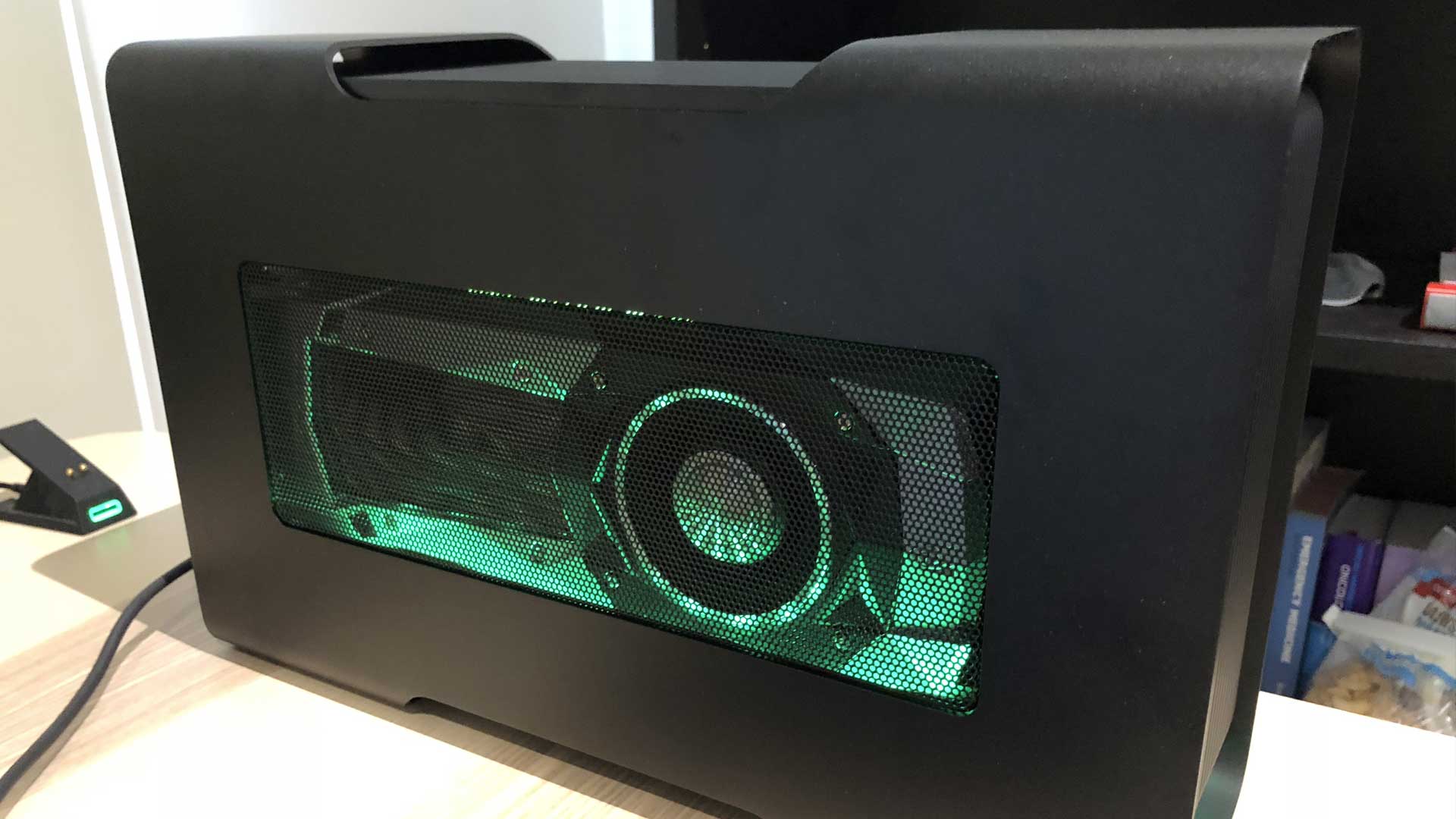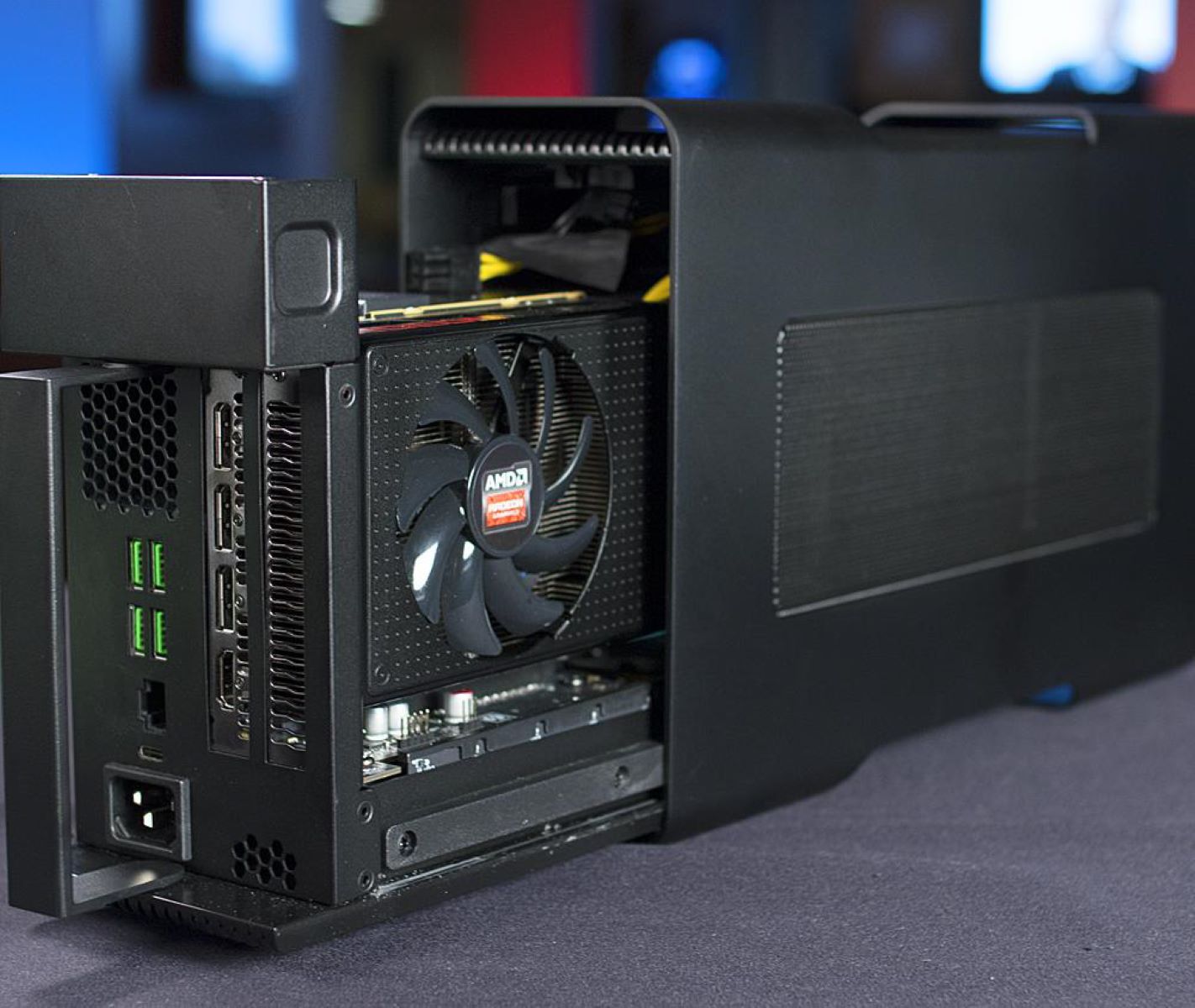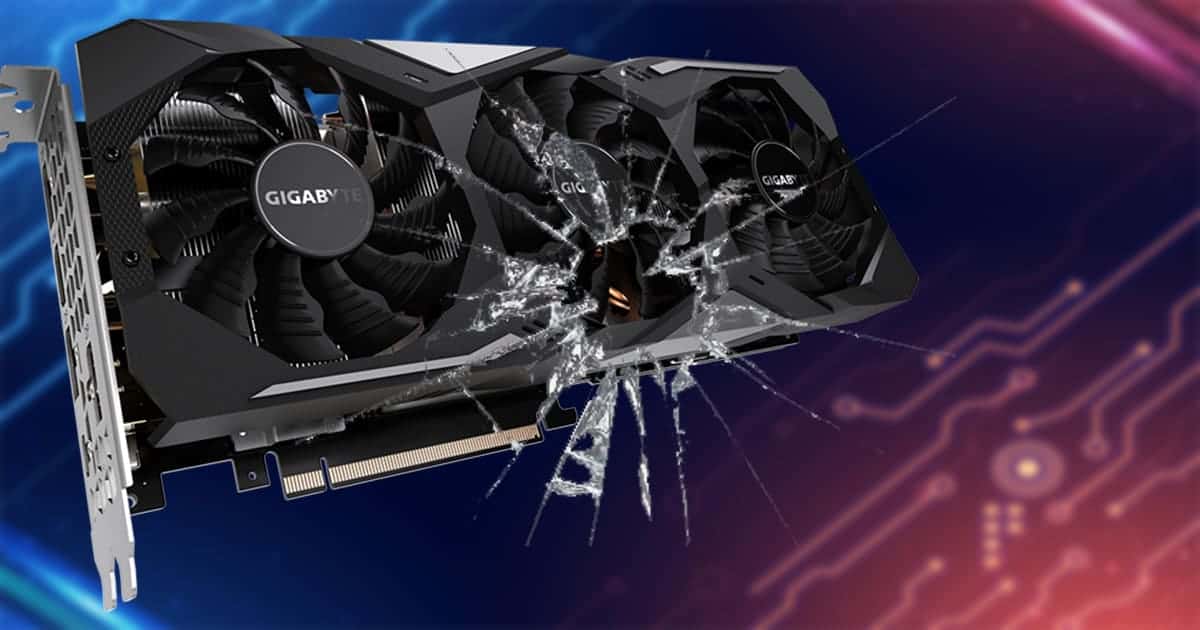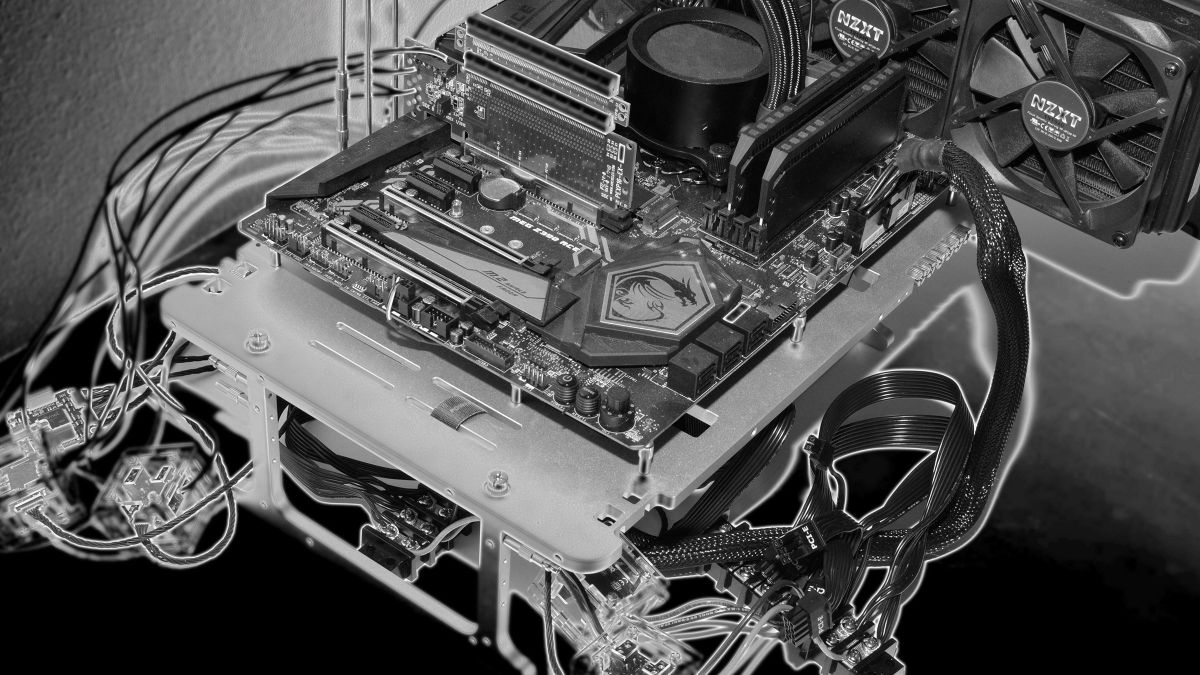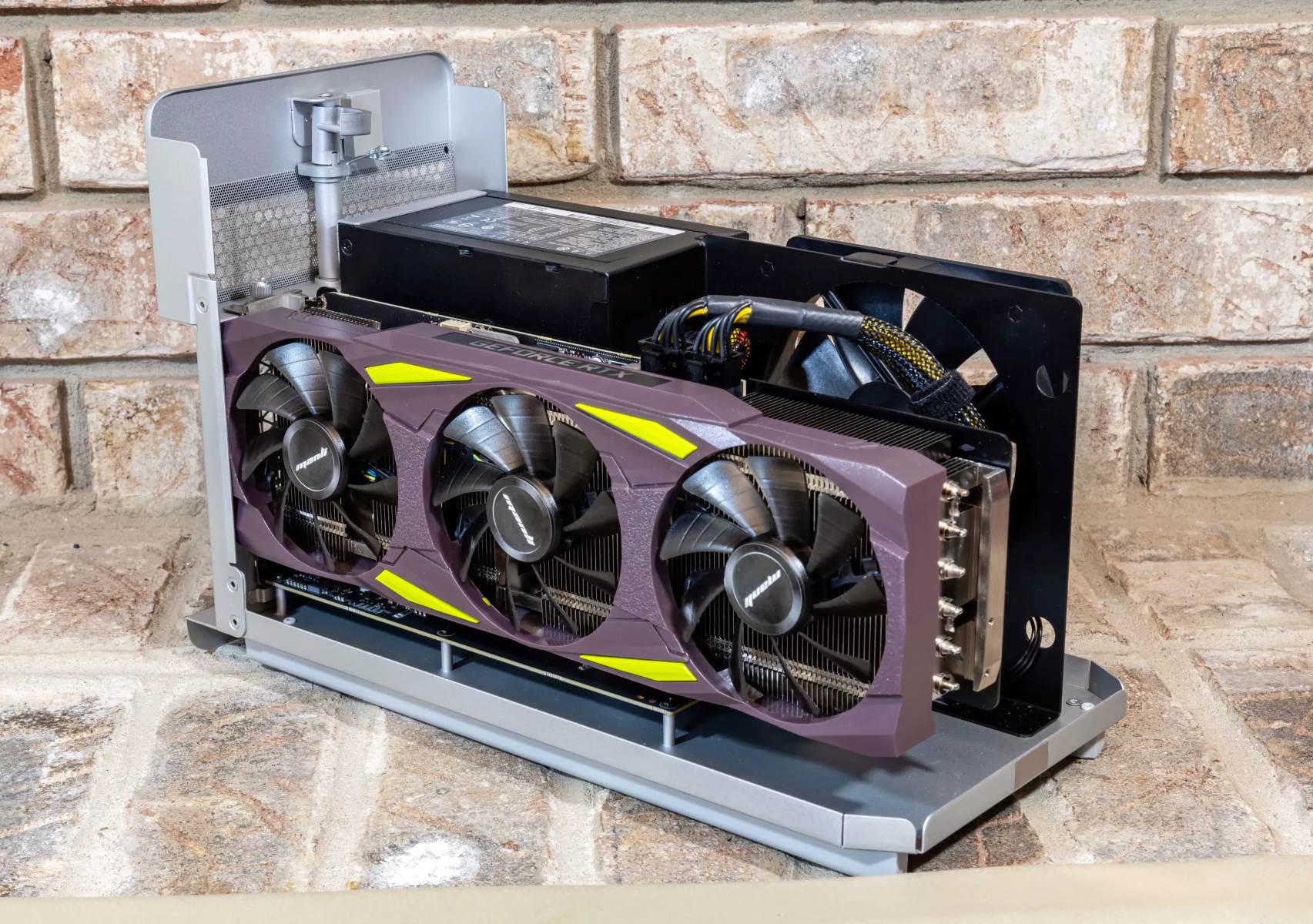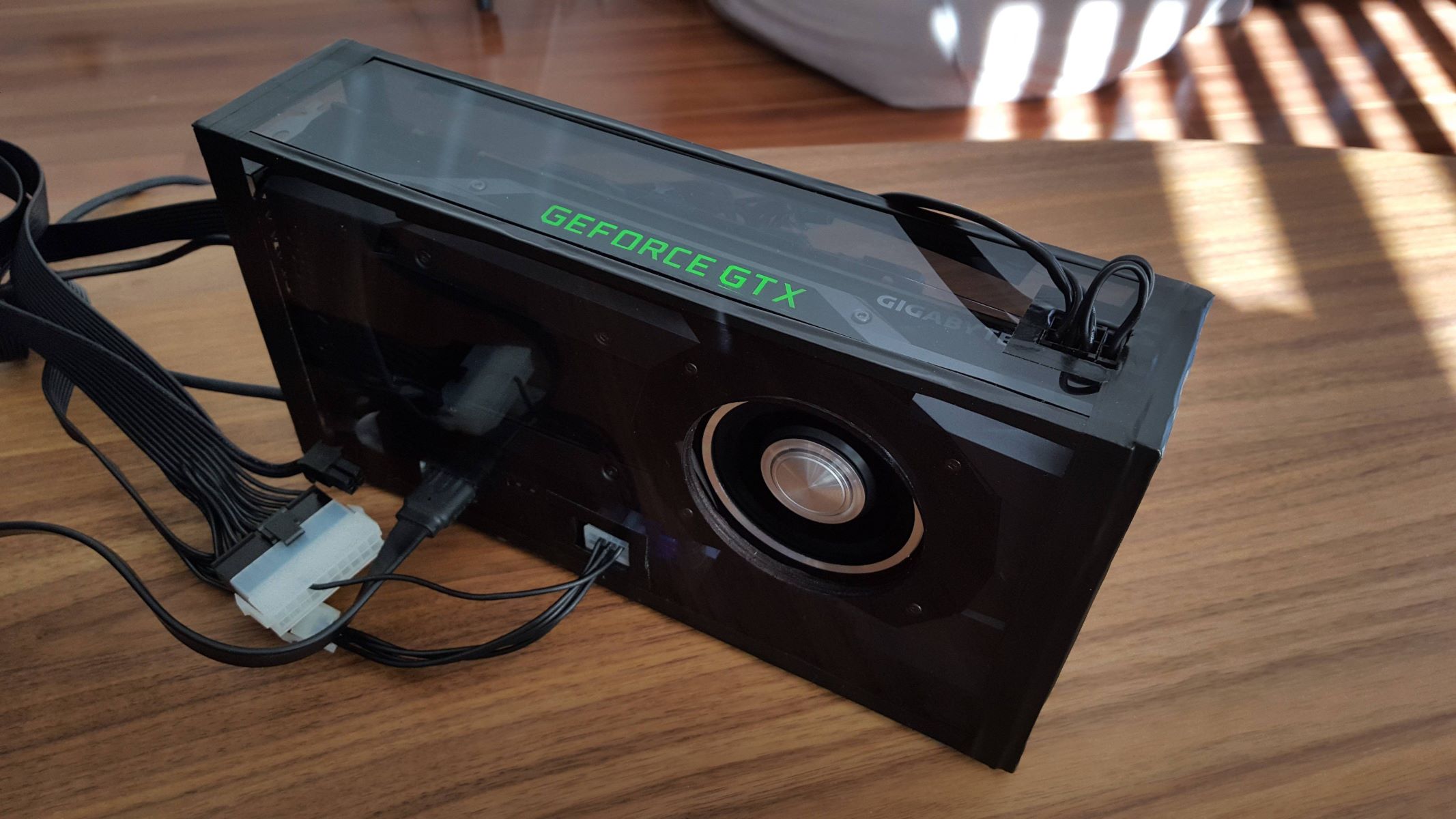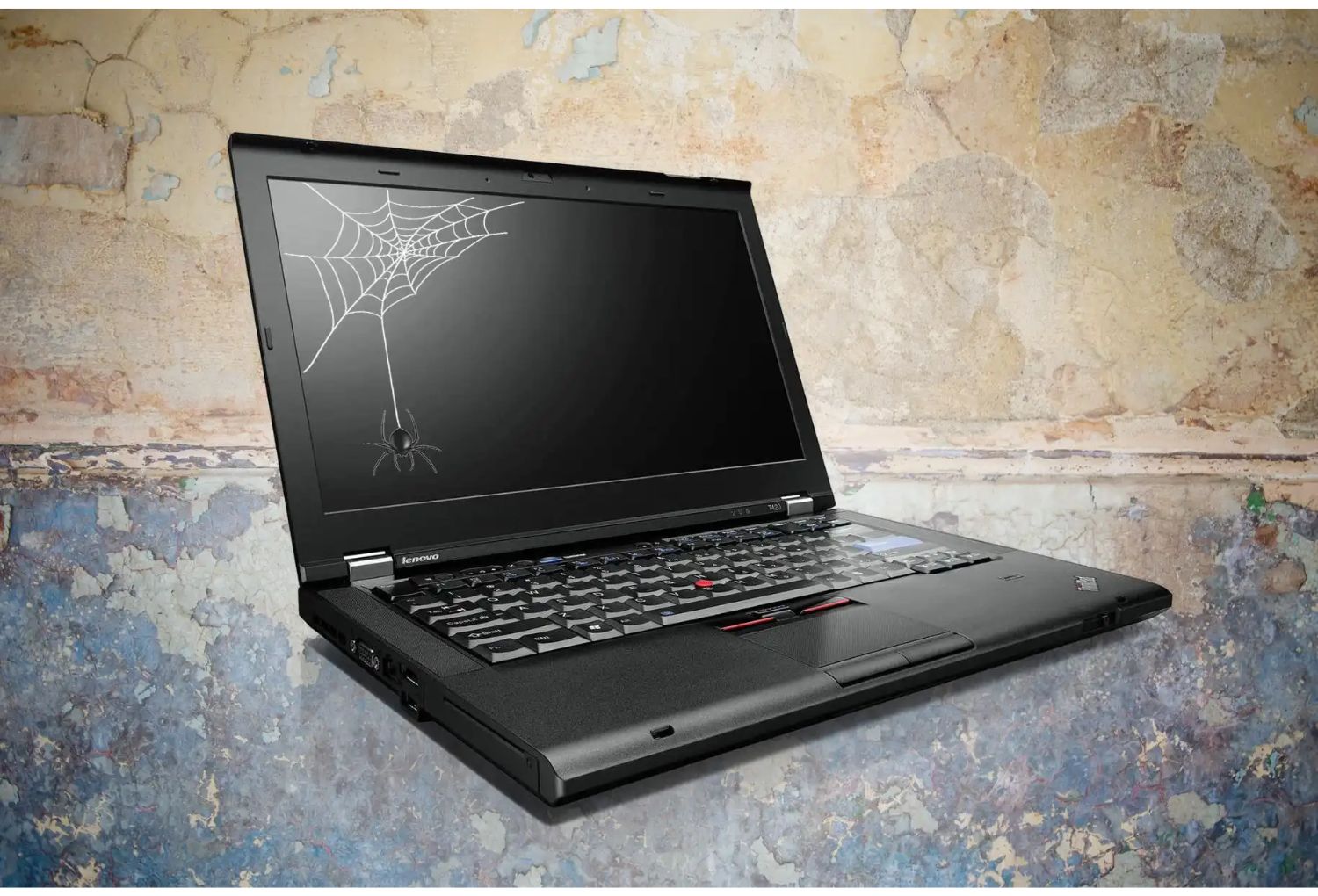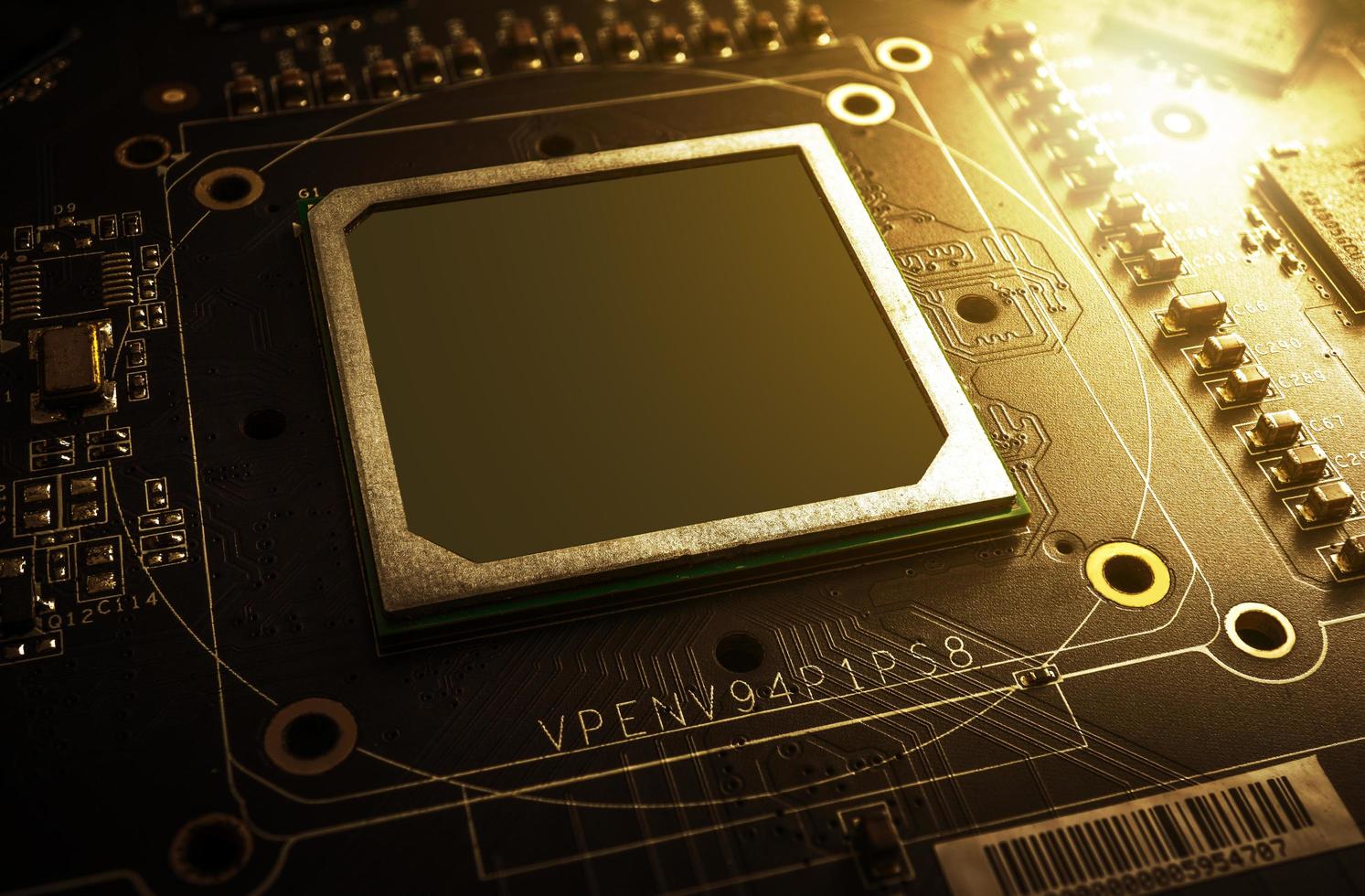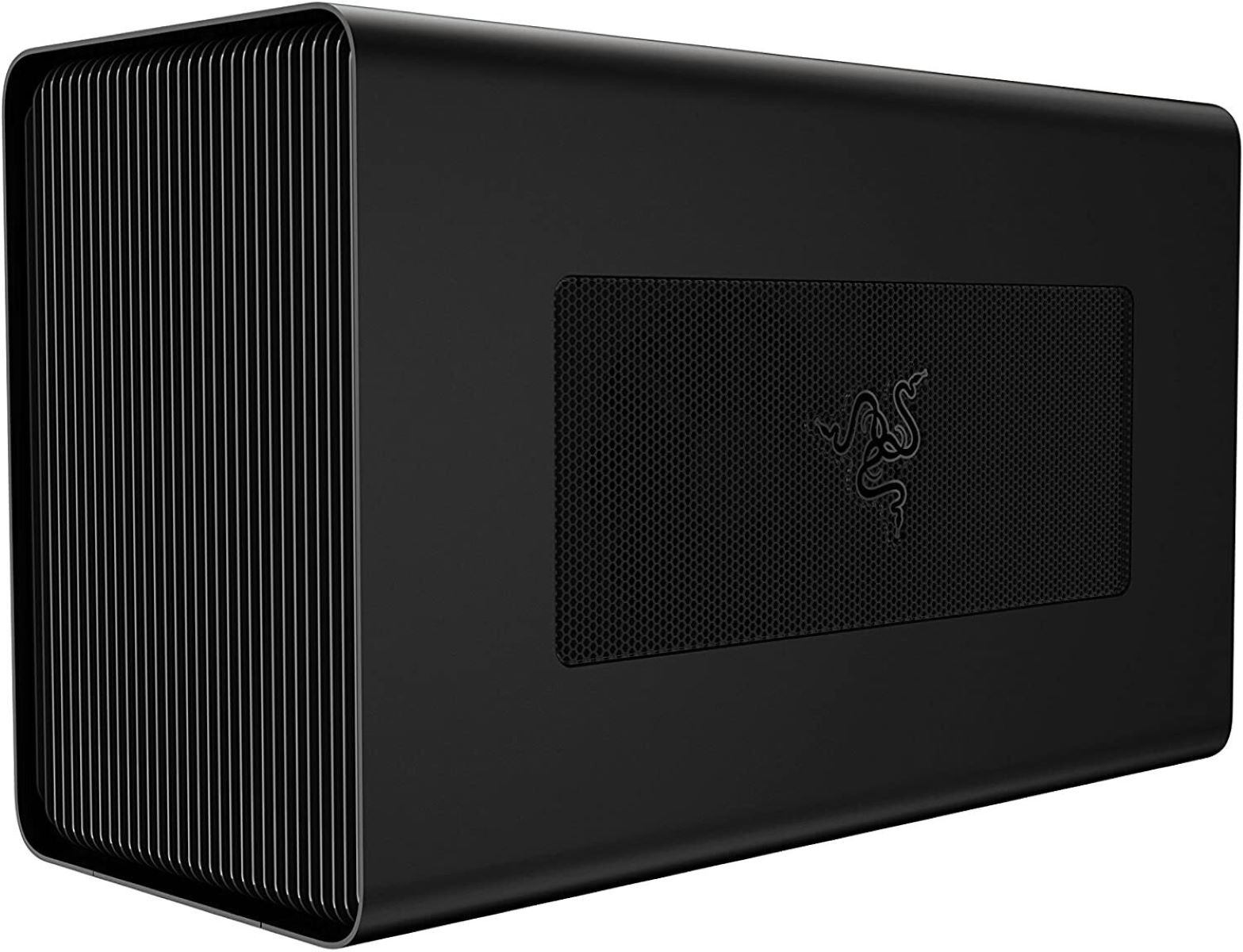Introduction
As technology continues to advance, the demand for powerful graphics capabilities has increased exponentially. In the past, the only way to achieve high-quality graphics and smooth gameplay was to invest in a high-end desktop computer equipped with a dedicated graphics card. However, advancements in technology have given rise to a new solution – the external GPU (eGPU).
An external GPU, as the name suggests, is a separate graphics processing unit that can be connected to a computer or laptop via a cable. It provides a significant boost in graphics performance, allowing users to enjoy high-resolution graphics, play demanding video games, and perform graphics-intensive tasks without the need for a bulky, expensive desktop system. The eGPU acts as a supplement to the built-in graphics capabilities of the computer, enhancing performance and expanding the graphical capabilities.
While external GPUs were initially designed for gamers, they have gained popularity among professionals who require powerful graphics capabilities for tasks such as video editing, 3D rendering, and graphic design. The ability to connect an external GPU to a laptop or small form-factor desktop has opened up new possibilities for users who desire portability without sacrificing performance.
In this article, we will delve into the world of external GPUs, exploring how they work, their benefits and drawbacks, compatibility with different devices, popular brands and models, how to set them up, and their performance in gaming and other tasks. By the end, you will have a comprehensive understanding of external GPUs and whether they are the right solution for your computing needs.
What is an External GPU?
An external GPU, also known as an eGPU, is a separate graphics processing unit that can be connected to a computer or laptop to enhance its graphics performance. It is a viable solution for users who want to upgrade their system’s graphical capabilities without having to buy a new computer or invest in a high-end desktop setup.
The main purpose of an external GPU is to provide a significant boost in graphics performance, allowing users to enjoy smooth gameplay, high-resolution graphics, and improved video editing capabilities. It works by offloading the graphics processing tasks from the computer’s built-in graphics card to the dedicated external graphics card, which is often more powerful and capable of handling demanding graphical tasks.
To connect an external GPU to a computer or laptop, a Thunderbolt 3 port or a similar high-speed connection is typically required. The eGPU is housed in an external enclosure, which houses the graphics card, cooling system, and power supply. This enclosure is connected to the computer via a cable, allowing for seamless communication between the external GPU and the computer.
One of the key advantages of an external GPU is its flexibility and portability. Users can easily connect or disconnect the eGPU, making it a convenient solution for laptop users who want to enjoy desktop-like graphics capabilities when at home or in the office. Additionally, the ability to upgrade or swap out the external graphics card provides users with the freedom to adapt their setup to their evolving needs and stay up to date with the latest advancements in graphics technology.
It’s important to note that while an external GPU can significantly enhance the graphical capabilities of a computer, it cannot overcome the limitations of a slow or outdated CPU. The overall performance of the system will still depend on the CPU’s capabilities. However, for tasks that heavily rely on graphics processing, such as gaming, video editing, and 3D rendering, the external GPU can provide a remarkable performance boost.
In the next section, we will explore how an external GPU functions and how it interacts with the computer to deliver improved graphics performance.
How does an External GPU work?
To understand how an external GPU works, let’s start with the basics. Every computer or laptop is equipped with a built-in graphics processing unit (GPU), also known as an integrated graphics card. This GPU handles all the graphical tasks of the system, from rendering images on the screen to processing complex graphics-intensive applications.
However, integrated graphics cards often lack the power and performance required for demanding tasks such as gaming, video editing, or running graphics-intensive software. This is where an external GPU comes into play. It acts as a dedicated graphics card, providing additional graphical power to the system. The external GPU works in tandem with the built-in GPU, offloading the graphics processing tasks to the more powerful external unit.
The connection between the computer and the external GPU is usually achieved through a high-speed interface, such as a Thunderbolt 3 port. This enables the transfer of data between the two devices, allowing the external GPU to process graphics-intensive tasks and send the output back to the computer’s screen.
When an external GPU is connected, the computer’s operating system detects it as a separate graphics card and utilizes it alongside the built-in GPU. This process is known as GPU switching or GPU hot-swapping. The system then determines which GPU to use for specific tasks based on predefined settings or user preferences.
It’s important to note that not all computers or laptops support the use of an external GPU. The device must have a compatible connection interface, such as Thunderbolt 3, and the necessary drivers and software to recognize and utilize the external GPU. Additionally, the power supply of the system must be capable of supporting the additional power required by the external GPU.
The external GPU is housed in an enclosure, which includes the graphics card, cooling system, and power supply. This enclosure not only provides the necessary physical protection for the graphics card but also helps dissipate the heat generated during intensive graphical tasks.
Overall, the external GPU functions as a supplemental graphical powerhouse, working alongside the built-in GPU to provide enhanced graphics performance. Whether you’re a gamer, a content creator, or a professional in need of high-quality graphics capabilities, an external GPU can significantly enhance your computing experience.
In the next section, we will explore the benefits of using an external GPU and how it can improve your overall computing experience.
Benefits of using an External GPU
Using an external GPU (eGPU) comes with a range of benefits that can greatly enhance your computing experience. Whether you’re a gamer, a content creator, or a professional in need of powerful graphics capabilities, here are some key advantages of incorporating an external GPU into your setup.
1. Improved Graphics Performance: The most obvious benefit of an external GPU is the significant boost in graphics performance it provides. With a more powerful graphics card, you can enjoy smooth gameplay, high frame rates, and stunning visuals in your favorite games. Similarly, video editing and 3D rendering tasks become faster and more efficient with the increased graphical power.
2. Flexibility and Portability: One of the standout advantages of an eGPU is its flexibility. You can easily connect or disconnect the external GPU, making it a portable solution. This is especially useful for laptop users who want to enjoy desktop-level graphics capabilities when at home or in the office. You can take your eGPU with you on the go or leave it at home, depending on your needs.
3. Future-Proofing: Upgrading or swapping out graphics cards in a traditional desktop setup can be a cumbersome process. However, with an external GPU, you have the freedom to easily upgrade your graphics card as new, more powerful models are released. This future-proofs your setup and ensures you can keep up with the latest advancements in graphics technology without having to replace your entire system.
4. Increased Compatibility: An external GPU can enhance the graphical capabilities of a wide range of devices, including laptops and small form-factor desktops that may have limited internal upgrade options. This means you can enjoy high-quality graphics on devices that would typically struggle to deliver satisfactory performance for gaming or graphics-intensive tasks.
5. Reduced Heat and Noise: Gaming and other graphics-intensive tasks can put a strain on the system, leading to increased heat and noise. With an external GPU, the heat generated by the graphics card is contained within the external enclosure, reducing the heat buildup inside your computer or laptop. This can help maintain lower operating temperatures and reduce the need for noisy cooling fans.
6. Cost-Effective Solution: Investing in an external GPU can be a cost-effective solution compared to buying a whole new computer or upgrading all internal components to achieve better graphics performance. Instead, you can simply add an external GPU to your existing setup and enjoy the benefits of improved graphics without breaking the bank.
In summary, incorporating an external GPU into your computing setup can significantly enhance your graphics performance, provide flexibility and portability, future-proof your system, increase compatibility with various devices, reduce heat and noise, and save you money. With these benefits in mind, it’s no wonder that external GPUs have become a popular choice among gamers, content creators, and professionals looking for a performance boost in their graphical tasks.
Drawbacks of using an External GPU
While external GPUs (eGPUs) offer compelling advantages, it’s important to consider the potential drawbacks before deciding to incorporate one into your computing setup. Here are some key drawbacks to keep in mind:
1. Limited Compatibility: Not all computers or laptops are compatible with external GPUs. The device must have a compatible connection interface, such as Thunderbolt 3, and the necessary drivers and software to recognize and utilize the eGPU. Additionally, the power supply of the system must be capable of supporting the additional power required by the external GPU.
2. Additional Cost: While an eGPU can be a cost-effective solution compared to buying a new computer or upgrading internal components, it still requires a separate investment. You need to consider the cost of both the external GPU and the enclosure, which can vary depending on the model and brand. Furthermore, you may also need to purchase additional accessories, such as a compatible cable or power adapter.
3. Increased Complexity: Setting up and configuring an eGPU can be more complex than simply upgrading an internal graphics card. It may involve installing specific drivers, firmware updates, or even modifying system settings. Furthermore, software support for eGPUs can be limited, with some applications or games not fully optimized to take advantage of the additional graphics processing power. This can result in compatibility issues or suboptimal performance in certain scenarios.
4. Reduced Portability: While an eGPU can provide portability for laptops, it also adds bulk and weight to your setup. The external enclosure and the extra cables needed for connectivity can make it less convenient to carry your laptop around. Additionally, you may need to find a power source for the eGPU, further limiting mobility.
5. Potential Bottlenecking: The overall performance of an eGPU setup depends not only on the GPU but also on other components of the computer, such as the CPU and RAM. If the CPU or RAM is not powerful enough, it can create a bottleneck and limit the potential gains from using an eGPU. It’s important to have a balanced system to fully leverage the benefits of an eGPU.
6. Noisy Cooling System: External GPU enclosures require cooling systems to dissipate the heat generated by the graphics card. While these cooling systems are necessary, they can also contribute to increased noise levels during intensive tasks. This can be a concern for users who value a quiet computing environment.
In summary, the drawbacks of using an external GPU include limited compatibility, additional cost, increased complexity during setup and configuration, reduced portability, potential bottlenecks, and the potential for a noisy cooling system. It’s important to weigh these drawbacks against the benefits before deciding to invest in an eGPU setup. Ultimately, the decision will depend on your specific needs and priorities.
Compatibility with Different Devices
When considering the use of an external GPU (eGPU), it’s essential to understand its compatibility with different devices. While eGPUs offer an opportunity to enhance graphics performance, not all devices are equipped to support them. Let’s explore the compatibility factors to consider:
1. Connection interface: Most eGPUs require a high-speed connection interface, such as Thunderbolt 3, to establish a connection with the computer or laptop. This means your device must have the necessary ports to support the eGPU connection. Older device models may not feature Thunderbolt 3 or other compatible interfaces, limiting their compatibility with eGPUs.
2. Operating system support: Another crucial aspect is the operating system (OS) support for eGPUs. While eGPUs are generally compatible with both Windows and macOS, it’s important to check the specific requirements and supported OS versions for your chosen eGPU model. Older or less common operating systems may have limited or no support for eGPUs.
3. Driver and software support: eGPUs require specific drivers and software to function properly. Ensure that your device supports the necessary drivers and software for the eGPU you plan to use. Regular driver updates from the eGPU manufacturer can also improve compatibility and performance.
4. Power supply: The power supply of your device plays a vital role in eGPU compatibility. External GPUs require additional power to operate effectively. Therefore, your device must have an adequate power supply to handle the power demands of both the eGPU and the rest of the system. In some cases, an external power adapter may be required to provide sufficient power to the eGPU.
5. Form factor limitations: The physical size and shape of your device may also impact compatibility with eGPUs. Laptops or small form-factor desktops may have limited physical space and thermal management capabilities, making it more challenging to accommodate the external enclosure and manage heat dissipation effectively.
6. Manufacturer limitations: Some device manufacturers impose limitations or restrictions on using eGPUs. It’s crucial to check if your device manufacturer explicitly supports or provides guidance on using eGPUs. For instance, some manufacturers may only support specific eGPU models or restrict their use to certain device lines or configurations.
It’s worth noting that even when devices meet the compatibility requirements, the overall performance of an eGPU setup can be influenced by other factors, such as the CPU, RAM, and internal storage speed. It’s essential to evaluate the entire system configuration to ensure a well-balanced setup for optimal performance.
In summary, compatibility with different devices involves considerations such as the connection interface, operating system support, driver and software compatibility, power supply capabilities, form factor limitations, and manufacturer restrictions. By ensuring compatibility, you can maximize the benefits of an eGPU and enjoy the enhanced graphics performance it provides.
Brands and Models of External GPUs
When it comes to choosing an external GPU (eGPU), there are several reputable brands and models available in the market. Each brand offers a range of options with different specifications and features to cater to various user needs. Let’s explore some prominent brands and models of eGPUs:
1. Razer Core X: Razer is known for its high-quality gaming peripherals, and the Razer Core X is one of their popular eGPU models. It features a spacious enclosure, support for a wide range of graphics cards, and Thunderbolt 3 connectivity. It offers flexibility and compatibility with both Windows and macOS systems.
2. ASUS ROG XG Station 2: The ASUS ROG XG Station 2 is a well-regarded eGPU option loved by gaming enthusiasts. It supports a variety of graphics cards, features a unique aesthetic design, and offers additional connectivity options like USB and ethernet ports. The XG Station 2 is compatible with both ASUS and non-ASUS laptops.
3. Gigabyte AORUS Gaming Box: The Gigabyte AORUS Gaming Box is a compact and portable eGPU solution that packs a powerful punch. It comes with various graphics card options, Thunderbolt 3 connectivity, and additional USB ports. The Gaming Box is highly compatible and offers an appealing blend of performance and convenience.
4. Blackmagic eGPUs: Blackmagic Design offers eGPU solutions specifically designed for professional video editing and content creation. Their eGPUs, like the Blackmagic eGPU and eGPU Pro, come with sleek enclosures, powerful AMD Radeon graphics cards, and additional connectivity options like HDMI and USB ports. They are optimized for use with Mac systems and offer impressive performance for graphic-intensive tasks.
5. Sonnet eGFX Breakaway Box: The Sonnet eGFX Breakaway Box is a versatile eGPU solution available in different models. It boasts spacious enclosures, support for a wide range of graphics cards, and excellent compatibility. The Breakaway Box offers various connectivity options and features a robust design suitable for demanding users.
6. PowerColor Devil Box: The PowerColor Devil Box is a popular choice known for its affordability and performance. It offers Thunderbolt 3 connectivity, support for various graphics cards, and additional USB and SATA ports for enhanced connectivity. The Devil Box ensures a seamless gaming experience and is compatible with both Windows and macOS systems.
It’s important to consider factors such as compatibility, performance, pricing, and specific requirements when choosing an eGPU. Factors like the desired level of graphics performance, the intended use, and the budget should be taken into account as well. Additionally, staying informed about reviews, benchmarks, and user experiences can provide valuable insights for making an informed decision.
In summary, there are several reputable brands and models of eGPUs available, ranging from options designed for gaming to solutions tailored for professional content creation. By considering your specific needs and comparing the specifications and features of different brands and models, you can find the best eGPU that suits your requirements and enhances your computing experience.
Setting up an External GPU
Setting up an external GPU (eGPU) involves a few essential steps to ensure a seamless integration with your computer or laptop. While the specific steps may vary depending on the brand and model of your eGPU, here is a general outline to guide you through the setup process:
1. Check compatibility: Verify that your computer or laptop meets the requirements for using an eGPU. Ensure you have a compatible connection interface, such as Thunderbolt 3, and the necessary drivers and software to support the eGPU.
2. Purchase the eGPU: Research and select the most suitable eGPU model for your needs. Consider factors such as performance, connectivity options, and brand reputation. Purchase the eGPU along with any necessary accessories, such as a compatible cable or power adapter.
3. Prepare your computer: Update your computer’s operating system to the latest version and install any necessary driver updates. This ensures optimal compatibility between your computer and the eGPU.
4. Connect the eGPU: Connect the eGPU enclosure to your computer or laptop using the provided cable. Ensure that the connection is secure and properly seated. If your eGPU requires additional power, connect the power adapter to an appropriate power source.
5. Install the eGPU software: Install the specific drivers and software necessary for your eGPU model. These can usually be downloaded from the manufacturer’s website. Follow the installation instructions and restart your computer if prompted.
6. Configure the eGPU settings: Once the drivers and software are installed, access the eGPU settings either through the manufacturer’s software or your computer’s system settings. Configure any preferences or performance settings specific to your eGPU model.
7. Verify eGPU functionality: To ensure that the eGPU is functioning correctly, perform a test by running a graphics-intensive application or game. Monitor the performance and verify that the eGPU is being utilized instead of the built-in GPU. If needed, adjust the settings to prioritize the eGPU for specific applications or tasks.
8. Monitor and update: Regularly check for driver updates and install them as needed. This ensures that you have the latest features, bug fixes, and performance optimizations for your eGPU model.
It’s important to follow the specific instructions provided by the eGPU manufacturer for the best setup experience. Additionally, referring to online resources, user guides, and forums dedicated to eGPUs can provide valuable insights and troubleshooting tips.
In summary, setting up an external GPU involves checking compatibility, purchasing the eGPU and necessary accessories, preparing your computer, connecting the eGPU, installing the drivers and software, configuring the settings, verifying functionality, and staying updated with driver updates. By following these steps and the specific instructions for your eGPU model, you can enjoy enhanced graphics performance and a seamless eGPU setup.
Performance and Gaming with an External GPU
When it comes to performance and gaming, an external GPU (eGPU) can make a significant difference, especially for laptops and devices with integrated graphics cards. Here, we will explore how an eGPU can improve gaming experiences and enhance overall system performance.
Graphics Performance: One of the primary benefits of using an eGPU for gaming is the substantial boost in graphics performance. An eGPU provides an extra dose of graphical power compared to integrated graphics, allowing for higher frame rates, increased visual fidelity, and smoother gameplay. The enhanced graphics performance enables gamers to enjoy the latest demanding titles, even on laptops that would otherwise struggle to run them.
High-Resolution Gaming: With an eGPU, gamers can achieve higher resolutions and screen refresh rates. This means you can immerse yourself in stunning visuals with sharper details and smoother animations. Whether you’re playing fast-paced action games or exploring visually rich open-world environments, an eGPU ensures your gaming experience is top-notch.
Ray Tracing and VR Support: Many modern games utilize advanced graphics technologies like real-time ray tracing and virtual reality (VR). These technologies require substantial graphical power, which integrated graphics may not handle well. With an eGPU, you can enjoy the full potential of these immersive technologies, creating lifelike visuals and enabling smooth VR experiences.
Game Streamers and Content Creators: For game streamers and content creators, an eGPU can be a game-changer. Streaming and content creation often involve resource-intensive tasks such as video encoding and rendering. With the increased graphics performance of an eGPU, these tasks become more efficient and faster, allowing for seamless streaming, high-quality video editing, and smooth real-time rendering.
Multi-Display Setups: An eGPU can also power multiple displays, making it an ideal choice for users who require a multi-monitor setup. Whether for productivity purposes or gaming immersion, an eGPU can handle the increased graphical load of driving multiple high-resolution displays simultaneously.
It’s important to note that while an eGPU can significantly enhance graphics performance, other factors such as the CPU, RAM, and storage speed also play a role in overall system performance. Having a well-balanced system will ensure that you can fully leverage the benefits of the eGPU.
However, it’s worth mentioning that while an eGPU can greatly improve gaming and overall performance, it may not match the performance of a high-end desktop with a dedicated graphics card. The connection between the eGPU and the computer can introduce a slight latency compared to an internal GPU, which can impact real-time gaming responsiveness. Nevertheless, the performance gains with an eGPU are still substantial and can transform a mediocre gaming setup into a powerful gaming rig.
In summary, an eGPU significantly enhances graphics performance and allows for high-resolution gaming, ray tracing, VR support, and improved multitasking capabilities. Whether you’re a gamer, content creator, or streamer, an eGPU can provide the necessary graphical power to elevate your gaming experiences or intensive tasks to the next level.
Cost Considerations of an External GPU
When considering an external GPU (eGPU) as an upgrade to your computer or laptop, there are several cost considerations to keep in mind. While an eGPU can be a cost-effective solution compared to buying a new system or upgrading internal components, it’s important to evaluate both the upfront and long-term costs involved.
1. Upfront Cost: The initial cost of purchasing an eGPU can vary depending on the brand, model, and specifications. Generally, the cost of an eGPU enclosure ranges from moderate to high, with more premium models offering additional features or better build quality. Additionally, you will need to factor in the cost of the graphics card itself, as some eGPU enclosures may not include one. It’s important to set a budget and carefully research and compare options to find an eGPU that fits your requirements and financial constraints.
2. Compatibility: Before investing in an eGPU, evaluate the compatibility of your existing system. Some laptops or computers may require additional accessories, such as a compatible cable or power adapter, which can add to the overall cost. Additionally, it’s crucial to ensure your device has a compatible connection interface, such as Thunderbolt 3, to establish a connection with the eGPU. Consider any extra expenses that may arise while making your purchasing decision.
3. Graphics Card Cost: If the eGPU enclosure does not include a graphics card, you need to factor in the cost of purchasing one separately. The price of graphics cards can vary significantly based on performance, brand, and model. High-performance graphics cards tend to be more expensive, but they can provide a substantial boost in graphical capabilities. Consider your gaming or performance requirements and balance them with your budget to select a suitable graphics card.
4. Power Supply and Additional Accessories: Depending on the eGPU model, you may require an external power adapter or additional accessories to operate the eGPU effectively. These accessories may come at an extra cost and should be taken into account during your decision-making process.
5. Long-Term Upgrade Potential: An advantage of an eGPU setup is the possibility of future upgrades. However, it’s essential to consider the potential cost of upgrading the graphics card over time. Prices for newer, more powerful graphics cards can be high, and you should factor this into your long-term cost calculations. Research the upgrade potential of the eGPU enclosure and ensure it meets your future needs and can accommodate the graphics card upgrades you may desire.
6. Performance Gains: Take into account the value you will gain from the eGPU in terms of improved graphics performance and overall system performance. If you are primarily a casual gamer or do not have a significant need for high-end graphical capabilities, the cost of an eGPU setup may not be justifiable. However, for gamers, content creators, or professionals who heavily rely on graphical power, the improved performance can be well worth the investment.
In summary, cost considerations of an eGPU include the upfront cost of the eGPU enclosure and graphics card, additional accessories, compatibility requirements, the potential cost of future upgrades, and the value gained from improved graphics and system performance. By carefully evaluating these aspects and weighing them against your budget and requirements, you can make an informed decision about whether an eGPU setup is a cost-effective choice for you.
Conclusion
External GPUs (eGPUs) have emerged as a compelling solution for users seeking to enhance their computer or laptop’s graphical capabilities. This article has provided an in-depth exploration of eGPUs, covering their definition, functionality, benefits, drawbacks, compatibility considerations, popular brands and models, setup process, gaming performance, and cost considerations.
eGPUs offer a range of benefits, including improved graphics performance, flexibility, future-proofing, increased compatibility, and reduced heat and noise. They provide a cost-effective solution for users who want to upgrade their systems without investing in new computers or upgrading internal components. eGPUs are highly appealing to gamers, content creators, and professionals who require powerful graphics capabilities for demanding tasks such as video editing, 3D rendering, or gaming.
However, the use of eGPUs does come with some drawbacks, such as limited compatibility, additional cost, increased complexity in setup and configuration, reduced portability, potential bottlenecks, and the possibility of a noisy cooling system. These factors should be carefully considered before making the decision to invest in an eGPU setup.
Setting up an eGPU involves checking compatibility, purchasing the appropriate eGPU and necessary accessories, preparing your computer, connecting the eGPU, installing drivers and software, configuring settings, and verifying functionality. Following these steps, and the manufacturer’s specific instructions, ensures a smooth eGPU setup experience.
Performance gains with an eGPU are significant, particularly for gaming and graphics-intensive tasks. eGPUs can offer improved graphics performance, high-resolution gaming, support for advanced technologies like ray tracing and VR, and enhanced multitasking capabilities. They provide gamers, content creators, and streamers with the graphical power needed to elevate their experiences and achieve professional-grade results.
It’s important to consider the cost aspects of an eGPU setup, including the upfront cost of the eGPU enclosure, graphics card, and any additional accessories, as well as potential long-term upgrade costs. Evaluating compatibility requirements and the value gained from improved graphics and system performance is crucial in determining whether an eGPU setup is a cost-effective choice for your specific needs and budget.
In conclusion, external GPUs offer a compelling solution to enhance graphics performance and elevate the computing experience. By carefully assessing compatibility, considering cost factors, and understanding the benefits and limitations, users can make informed decisions about incorporating an eGPU into their setups. Whether for gaming, content creation, or professional tasks, an eGPU can provide the necessary graphical power to meet the demands of modern applications and deliver a visually immersive experience.







